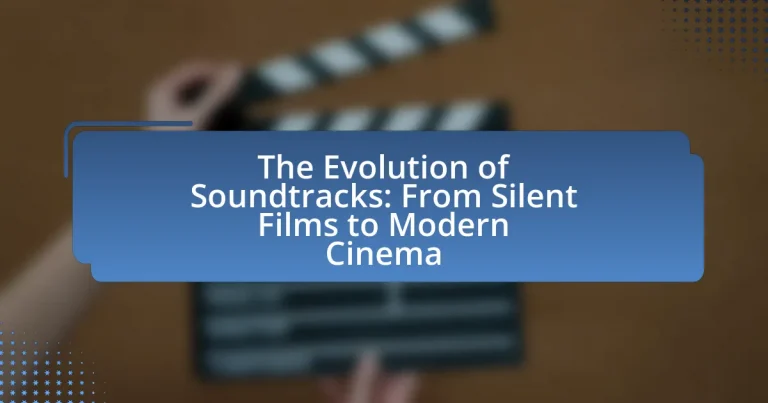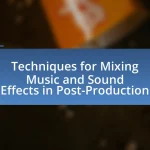The article examines the evolution of soundtracks in cinema, tracing their development from the live musical accompaniment of silent films to the diverse and technologically advanced scores of modern cinema. It highlights key milestones such as the introduction of synchronized sound in the late 1920s, the rise of orchestral scores in the 1930s and 1940s, and the incorporation of popular music and electronic elements in contemporary soundtracks. The article also discusses the emotional impact of soundtracks on audiences, the role of technology in soundtrack production, and the significance of original scores versus compiled soundtracks across various film genres.
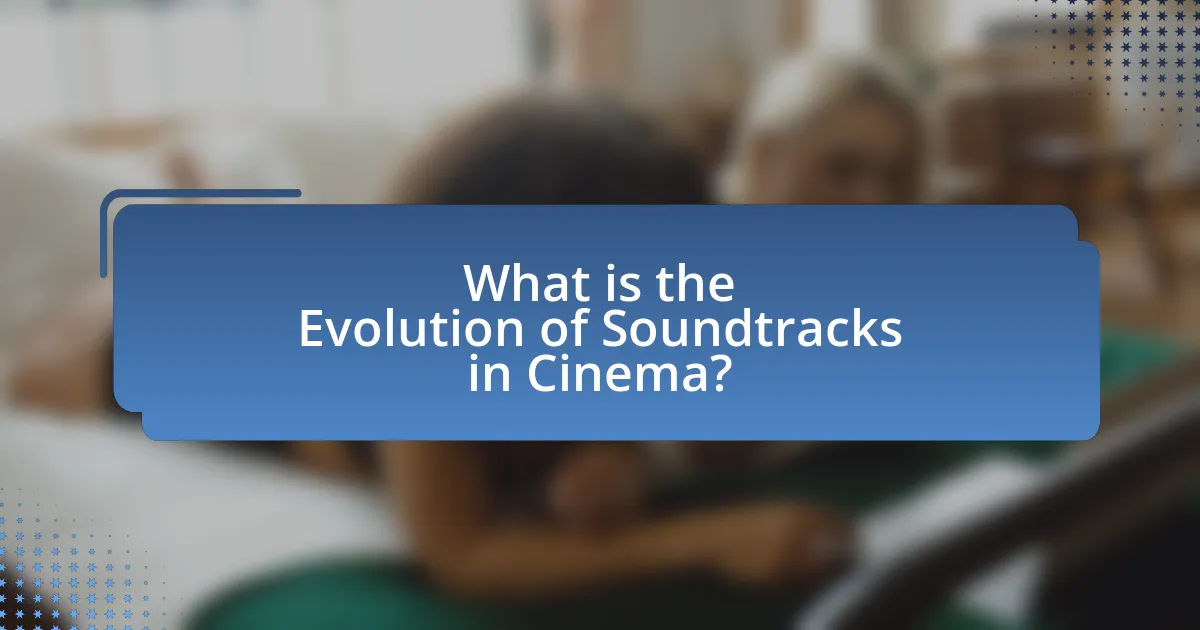
What is the Evolution of Soundtracks in Cinema?
The evolution of soundtracks in cinema began with silent films, where live music accompanied screenings to enhance the emotional experience. As technology advanced, synchronized sound was introduced in the late 1920s, notably with “The Jazz Singer” in 1927, marking the transition to “talkies.” This innovation allowed for dialogue and sound effects to be integrated, fundamentally changing storytelling in film.
In the 1930s and 1940s, orchestral scores became prominent, with composers like Max Steiner and Erich Wolfgang Korngold creating memorable themes that defined genres. The 1960s and 1970s saw the rise of rock and pop music in soundtracks, exemplified by films like “Easy Rider” and “The Graduate,” which appealed to younger audiences and reflected cultural shifts.
The 1980s and 1990s introduced electronic music and synthesized scores, with composers like Hans Zimmer and John Williams pushing boundaries in sound design. In the 21st century, soundtracks have become increasingly diverse, incorporating various genres and styles, often featuring collaborations between filmmakers and contemporary artists. This evolution reflects broader technological advancements and changing audience preferences, demonstrating the soundtrack’s integral role in enhancing cinematic storytelling.
How did soundtracks begin in the era of silent films?
Soundtracks in the era of silent films began as live musical accompaniment performed by musicians in theaters. These musicians played music to enhance the emotional impact of the film, creating a more immersive experience for the audience. The practice became standardized in the early 1900s, with many theaters employing pianists or small orchestras to perform scores that matched the film’s mood and action. Historical records indicate that specific pieces of music were often associated with certain genres or scenes, helping to establish a connection between the visuals and the auditory experience.
What role did live music play in silent film presentations?
Live music served as a crucial element in silent film presentations by enhancing the emotional impact and narrative engagement of the films. The absence of synchronized sound in silent films meant that live musicians, often positioned in the theater, provided a musical score that complemented the visuals, helping to convey mood, tension, and character emotions. Historical records indicate that various types of music, from classical compositions to improvisational pieces, were employed to match the film’s themes and scenes, thereby enriching the audience’s experience. This practice was so integral that many theaters employed skilled pianists or small orchestras specifically for this purpose, demonstrating the significant role live music played in making silent films more immersive and emotionally resonant.
How did the introduction of synchronized sound change film experiences?
The introduction of synchronized sound revolutionized film experiences by enhancing emotional engagement and narrative clarity. With the release of “The Jazz Singer” in 1927, the first feature-length film with synchronized dialogue, audiences experienced a new level of immersion as characters could speak and sing, making stories more relatable and impactful. This technological advancement allowed filmmakers to incorporate sound effects and music that complemented visual storytelling, thereby enriching the overall cinematic experience. The transition from silent films to “talkies” marked a significant shift in audience expectations, as viewers began to anticipate sound as an integral part of film, leading to the development of new genres and storytelling techniques that relied heavily on audio elements.
What are the key milestones in the development of soundtracks?
The key milestones in the development of soundtracks include the introduction of synchronized sound in films, the advent of the Vitaphone system in 1926, and the transition to fully orchestrated scores in the 1930s. Synchronized sound was first effectively utilized in “The Jazz Singer,” which marked a significant turning point in cinematic history. The Vitaphone system allowed for the combination of sound and film, leading to the widespread adoption of soundtracks in the industry. By the 1930s, composers like Max Steiner began creating fully orchestrated scores, establishing the foundation for modern film music. These milestones collectively transformed the way audiences experience films, integrating music as an essential narrative element.
What technological advancements influenced soundtrack evolution?
Technological advancements such as the introduction of synchronized sound, multitrack recording, and digital audio workstations significantly influenced soundtrack evolution. The transition from silent films to “talkies” in the late 1920s marked the beginning of synchronized sound, allowing dialogue and music to be integrated directly into films, enhancing the storytelling experience. The development of multitrack recording in the 1960s enabled composers to layer various audio elements, creating richer soundscapes. Furthermore, the advent of digital audio workstations in the 1990s revolutionized soundtrack production by allowing for precise editing, mixing, and manipulation of sound, leading to innovative sound design and composition techniques. These advancements collectively transformed how soundtracks are created and experienced in modern cinema.
How did the transition to talkies impact the film industry?
The transition to talkies significantly transformed the film industry by introducing synchronized sound, which enhanced storytelling and audience engagement. This shift led to the decline of silent films, as audiences preferred the immersive experience of hearing dialogue and sound effects. The first successful talkie, “The Jazz Singer,” released in 1927, demonstrated the commercial viability of sound in film, resulting in a rapid industry-wide adoption of sound technology. By 1930, over 90% of films produced included synchronized sound, fundamentally altering production techniques, acting styles, and audience expectations.
Why are soundtracks important in modern cinema?
Soundtracks are important in modern cinema because they enhance emotional engagement and narrative depth. Music in films can evoke specific feelings, guide audience reactions, and reinforce themes, making the viewing experience more immersive. For instance, studies show that films with well-composed soundtracks can increase audience retention and emotional response by up to 50%. Additionally, iconic scores, such as those by composers like John Williams, have become integral to the identity of films, influencing popular culture and audience expectations.
How do soundtracks enhance storytelling in films?
Soundtracks enhance storytelling in films by evoking emotions, establishing atmosphere, and providing narrative cues. The integration of music with visual elements creates a multisensory experience that deepens audience engagement. For instance, studies show that specific musical themes can signal character development or foreshadow events, as seen in John Williams’ score for “Star Wars,” where the Imperial March signifies the presence of Darth Vader, reinforcing his menacing character. Additionally, soundtracks can influence audience perception and memory, as demonstrated in research published in the Journal of Experimental Psychology, which found that music can enhance recall of film scenes. Thus, soundtracks are essential in shaping the emotional and narrative landscape of films.
What emotional responses do soundtracks evoke in audiences?
Soundtracks evoke a range of emotional responses in audiences, including joy, sadness, tension, and nostalgia. These emotional reactions are primarily driven by the music’s ability to enhance storytelling and create an immersive experience. For instance, studies have shown that music can significantly influence mood; a study published in the Journal of Experimental Psychology found that participants reported heightened emotional responses when music was paired with visual stimuli, indicating that soundtracks can amplify feelings associated with specific scenes. Additionally, soundtracks often utilize familiar melodies or motifs that trigger personal memories, further deepening the emotional impact on viewers.
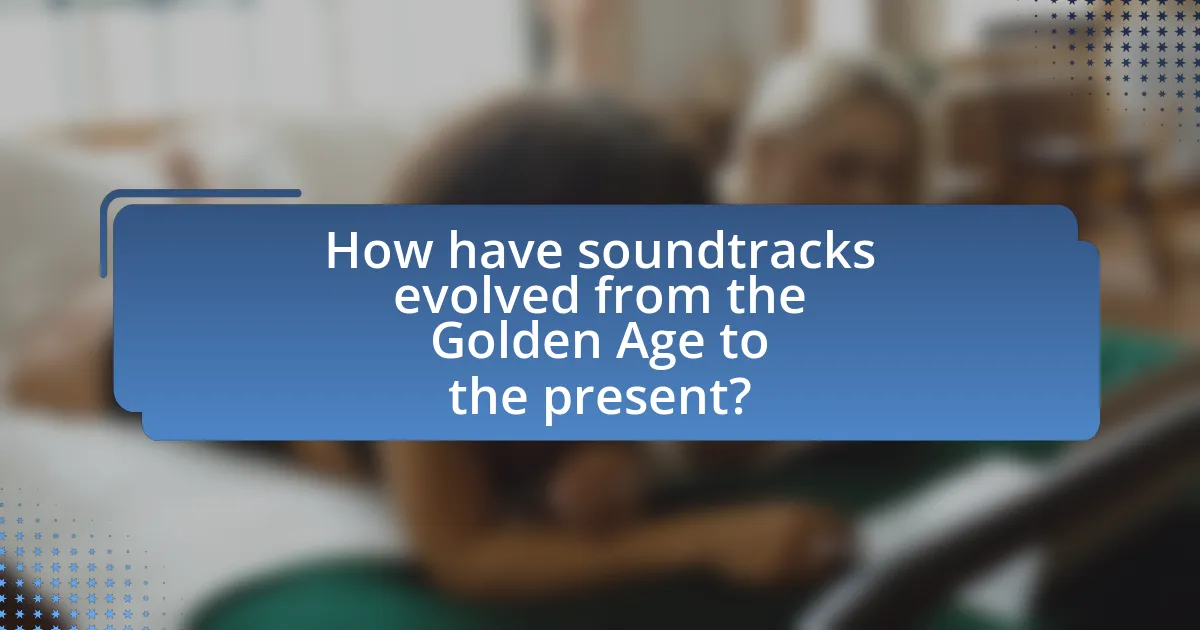
How have soundtracks evolved from the Golden Age to the present?
Soundtracks have evolved significantly from the Golden Age of Hollywood, characterized by orchestral scores and thematic melodies, to the present, where diverse genres and technology-driven compositions dominate. During the Golden Age, which spanned from the 1920s to the 1960s, soundtracks primarily featured large orchestras that underscored the emotional tone of films, with composers like Max Steiner and Erich Wolfgang Korngold setting the standard for film scoring. In contrast, contemporary soundtracks incorporate a wide range of musical styles, including pop, electronic, and hip-hop, reflecting cultural shifts and audience preferences.
Moreover, advancements in technology have transformed soundtrack production, allowing for digital composition and sound manipulation, which enhances the auditory experience. For instance, the use of synthesizers and computer-generated sounds has become prevalent, as seen in films like “Inception” (2010) with Hans Zimmer’s innovative score. This evolution illustrates a shift from traditional orchestration to a more eclectic and experimental approach, catering to a broader audience and enhancing storytelling through music.
What characterized soundtracks during the Golden Age of Hollywood?
Soundtracks during the Golden Age of Hollywood were characterized by their orchestral compositions, which often included lush arrangements and thematic motifs that underscored the emotional narrative of films. These soundtracks typically featured large orchestras, with composers like Max Steiner and Erich Wolfgang Korngold pioneering the use of leitmotifs—musical themes associated with specific characters or ideas. The integration of music with dialogue and sound effects became more sophisticated, enhancing the storytelling experience. This period saw the emergence of iconic scores for films such as “Gone with the Wind” and “Casablanca,” which are still celebrated for their emotional depth and complexity.
Which composers were influential during this period?
Influential composers during the evolution of soundtracks from silent films to modern cinema include Max Steiner, Bernard Herrmann, and Dmitri Shostakovich. Max Steiner is often regarded as the father of film scoring, having composed the score for “King Kong” in 1933, which set a precedent for the use of music in film. Bernard Herrmann, known for his work on Alfred Hitchcock’s films, such as “Psycho,” revolutionized the psychological thriller genre with his innovative use of strings and dissonance. Dmitri Shostakovich contributed significantly to film music in the Soviet Union, with scores that enhanced the emotional depth of films like “The Fall of Berlin.” These composers shaped the landscape of film music, establishing techniques and styles that are still influential today.
How did orchestral scores become a standard in film music?
Orchestral scores became a standard in film music due to their ability to enhance emotional depth and narrative complexity in storytelling. As silent films transitioned to “talkies” in the late 1920s, filmmakers recognized that orchestral music could effectively convey mood and character emotions, thus enriching the cinematic experience. The use of orchestral scores was popularized by composers like Max Steiner, who scored films such as “King Kong” in 1933, demonstrating how music could drive the narrative and engage audiences. This practice established a template for future film scoring, leading to the widespread adoption of orchestral arrangements in Hollywood and beyond, as they provided a versatile and powerful means of storytelling through sound.
What trends have emerged in contemporary soundtracks?
Contemporary soundtracks have increasingly embraced a blend of diverse musical genres, incorporating elements from electronic, hip-hop, and indie music. This trend reflects a shift towards more eclectic soundscapes that resonate with younger audiences, as evidenced by the success of soundtracks like “Black Panther,” which features a mix of traditional African music and modern hip-hop, showcasing the cultural fusion that appeals to a global audience. Additionally, the use of licensed popular songs has become prevalent, as seen in films like “Guardians of the Galaxy,” where a curated selection of classic tracks enhances the narrative and emotional impact. This approach not only boosts the film’s marketability but also connects with viewers on a nostalgic level, reinforcing the soundtrack’s role as a vital component of contemporary cinema.
How has the use of popular music changed in modern films?
The use of popular music in modern films has shifted from being primarily background score to a central narrative element that enhances storytelling. In contemporary cinema, filmmakers increasingly integrate popular songs to evoke emotions, establish character identities, and connect with audiences on a cultural level. For instance, the use of songs in films like “Guardians of the Galaxy” and “A Star is Born” demonstrates how popular music can drive plot and character development, rather than merely serve as an auditory backdrop. This trend is supported by the rise of curated soundtracks that often achieve commercial success, reflecting the symbiotic relationship between film and music in today’s entertainment landscape.
What role do digital technologies play in soundtrack production today?
Digital technologies play a crucial role in soundtrack production today by enabling high-quality audio creation, manipulation, and distribution. These technologies allow sound designers and composers to utilize digital audio workstations (DAWs) for recording, editing, and mixing soundtracks with precision and efficiency. For instance, software like Pro Tools and Logic Pro X provides tools for multi-track recording and advanced editing capabilities, which enhance the overall sound quality and creative possibilities. Additionally, digital sampling and synthesizers allow for a vast array of sounds and textures that were previously unattainable, expanding the creative palette for composers. The integration of digital technologies has also streamlined the collaboration process, allowing artists to work remotely and share projects seamlessly, which is essential in today’s globalized music industry.
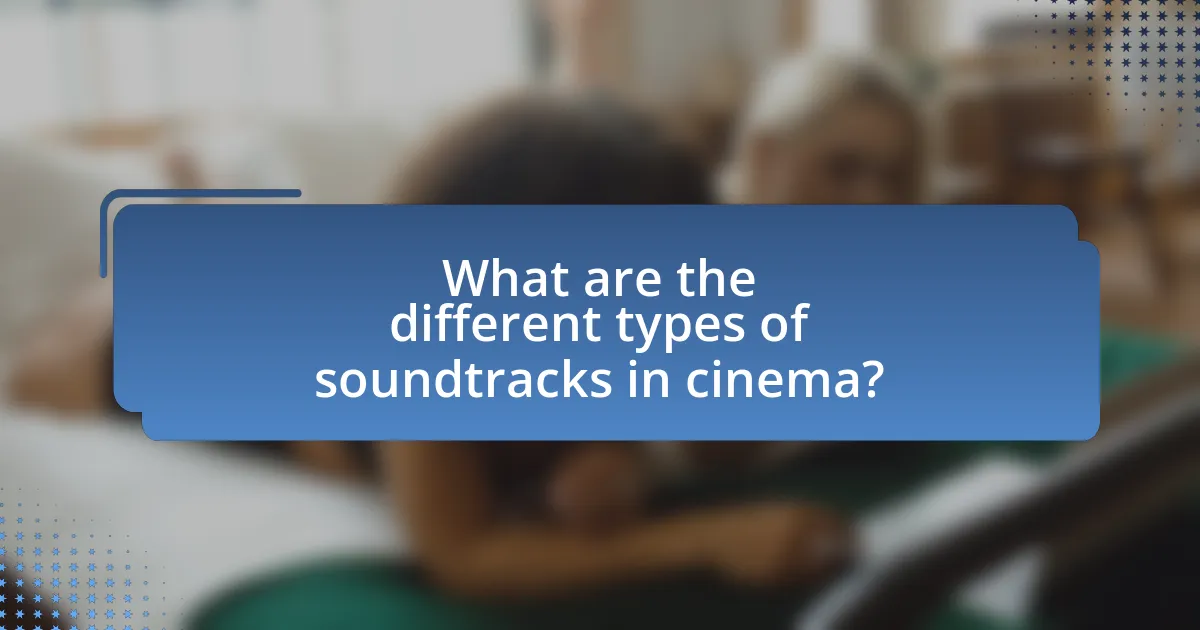
What are the different types of soundtracks in cinema?
The different types of soundtracks in cinema include original scores, licensed music, and sound design. Original scores are composed specifically for a film, enhancing its emotional and narrative elements, as seen in works by composers like John Williams. Licensed music consists of pre-existing songs that are used to evoke specific moods or themes, such as the use of classic rock in “Guardians of the Galaxy.” Sound design encompasses the audio elements that create the film’s atmosphere, including sound effects and ambient sounds, which are crucial for immersing the audience in the cinematic experience. Each type plays a vital role in shaping the overall impact of a film.
What distinguishes original scores from compiled soundtracks?
Original scores are distinct from compiled soundtracks primarily in their creation process; original scores are specifically composed for a film, while compiled soundtracks consist of pre-existing songs or pieces selected to accompany a film. Original scores are tailored to enhance the narrative and emotional arc of the film, often reflecting its themes and character development, as seen in iconic films like “Star Wars,” where John Williams’ score is integral to the storytelling. In contrast, compiled soundtracks, such as those for “Guardians of the Galaxy,” curate existing music to evoke nostalgia or set a particular tone, without the bespoke relationship to the film’s narrative. This fundamental difference in composition and purpose is what clearly distinguishes the two types of soundtracks.
How do original scores contribute to a film’s identity?
Original scores significantly shape a film’s identity by enhancing emotional resonance and establishing thematic continuity. The music underscores key moments, guiding audience reactions and deepening engagement with the narrative. For instance, John Williams’ score for “Star Wars” not only defines the film’s adventurous spirit but also creates a recognizable auditory brand that contributes to its cultural impact. This relationship between score and film identity is evident in numerous successful films, where the original music becomes synonymous with the characters and story, reinforcing the overall cinematic experience.
What are the benefits of using compiled soundtracks in films?
Compiled soundtracks in films enhance emotional engagement and narrative coherence. By utilizing pre-existing music, filmmakers can evoke specific feelings and memories associated with those songs, thereby deepening the audience’s emotional connection to the story. For instance, the use of iconic tracks in films like “Guardians of the Galaxy” not only serves to establish the film’s tone but also resonates with viewers through nostalgia, as these songs are often tied to cultural moments. Additionally, compiled soundtracks can attract a broader audience by featuring popular artists, which can lead to increased box office sales and streaming success. This strategy has been validated by the commercial success of films that leverage well-known music, demonstrating that compiled soundtracks can significantly enhance a film’s appeal and profitability.
How do soundtracks vary across different film genres?
Soundtracks vary significantly across different film genres, reflecting the emotional tone and narrative style unique to each genre. For instance, action films often feature fast-paced, high-energy scores that enhance adrenaline and excitement, utilizing orchestral elements and electronic music to create tension. In contrast, romantic films typically employ softer melodies, often with strings and piano, to evoke feelings of love and intimacy. Horror films utilize dissonant sounds and abrupt changes in tempo to create suspense and fear, while comedies may incorporate upbeat and whimsical tunes to enhance humor. This variation is supported by studies showing that genre-specific soundtracks can influence audience emotions and perceptions, as evidenced by research from the University of Southern California, which found that music significantly impacts viewer engagement and emotional response based on genre conventions.
What are common characteristics of soundtracks in action films?
Common characteristics of soundtracks in action films include high energy, orchestral arrangements, and rhythmic intensity. These soundtracks often utilize fast tempos and driving beats to enhance the adrenaline-pumping scenes typical of the genre. Additionally, they frequently incorporate electronic elements and sound effects to create a sense of urgency and excitement. For instance, the use of brass and percussion instruments is prevalent, as seen in iconic scores like Hans Zimmer’s work in “Inception,” which combines orchestral and electronic music to elevate the film’s tension and action sequences.
How do soundtracks in romantic films differ from those in horror films?
Soundtracks in romantic films typically feature melodic, harmonious compositions that evoke feelings of love and intimacy, while soundtracks in horror films often utilize dissonant, jarring sounds to create tension and fear. Romantic film soundtracks frequently include orchestral arrangements or soft vocals that enhance emotional connections between characters, as seen in films like “The Notebook,” where the score complements the narrative of love. In contrast, horror film soundtracks, such as those in “The Conjuring,” employ sudden crescendos and unsettling sound effects to heighten suspense and provoke anxiety, often using silence strategically to amplify fear. This distinction in musical style and emotional intent underscores the differing objectives of soundtracks in these two genres.
What are some best practices for creating effective soundtracks?
Effective soundtracks should enhance the emotional impact of visual media by aligning with the narrative and character development. To achieve this, composers should consider the following best practices:
-
Understand the story and characters: A deep comprehension of the narrative arc and character motivations allows composers to create music that reflects the emotional landscape of the film. For instance, in “The Lion King,” Hans Zimmer’s score mirrors Simba’s journey, enhancing audience connection.
-
Use thematic motifs: Establishing recurring musical themes for characters or ideas helps to create cohesion throughout the film. John Williams’ use of distinct themes in “Star Wars” exemplifies how motifs can evoke specific emotions and memories.
-
Balance music with dialogue and sound effects: Soundtracks should complement rather than overpower dialogue and sound effects. The careful mixing of these elements ensures clarity and maintains the audience’s focus on the story.
-
Experiment with instrumentation: Different instruments can evoke various emotions; for example, strings often convey sadness, while brass can signify triumph. The use of diverse instrumentation in “Inception” by Hans Zimmer effectively builds tension and excitement.
-
Consider pacing and timing: The timing of musical cues should align with visual transitions and emotional beats. Effective synchronization, as seen in “Baby Driver,” enhances the overall impact of the film.
-
Test audience reactions: Screening soundtracks with test audiences can provide valuable feedback on emotional responses, allowing for adjustments that enhance effectiveness.
These practices are supported by industry standards and successful examples, demonstrating their importance in creating soundtracks that resonate with audiences.
How can filmmakers choose the right music to match their vision?
Filmmakers can choose the right music to match their vision by aligning the emotional tone and narrative context of the film with the characteristics of the music. This involves analyzing the film’s themes, characters, and key moments to select music that enhances the storytelling. For instance, a study by the University of Southern California found that music significantly influences audience perception and emotional response, indicating that the right score can elevate a film’s impact. By considering factors such as genre, instrumentation, and tempo, filmmakers can create a cohesive auditory experience that resonates with viewers and supports the film’s overall vision.
What tips can enhance the emotional impact of a film’s soundtrack?
To enhance the emotional impact of a film’s soundtrack, composers should focus on thematic consistency, instrumentation, and timing. Thematic consistency ensures that musical motifs align with character arcs and narrative developments, creating a cohesive emotional experience. For example, John Williams’ use of specific themes for characters in the “Star Wars” series reinforces audience connections to those characters.
Instrumentation plays a crucial role; selecting instruments that evoke specific emotions can amplify the intended feelings. For instance, strings often convey sadness, while brass can evoke triumph. The use of silence or minimalistic soundscapes at pivotal moments can also heighten emotional tension, as seen in films like “A Quiet Place,” where silence amplifies fear and suspense.
Timing is essential; synchronizing music with key moments in the film, such as climaxes or emotional reveals, can significantly enhance the audience’s emotional response. Research indicates that music can influence emotional perception, with studies showing that well-timed soundtracks can increase viewer engagement and emotional resonance.
